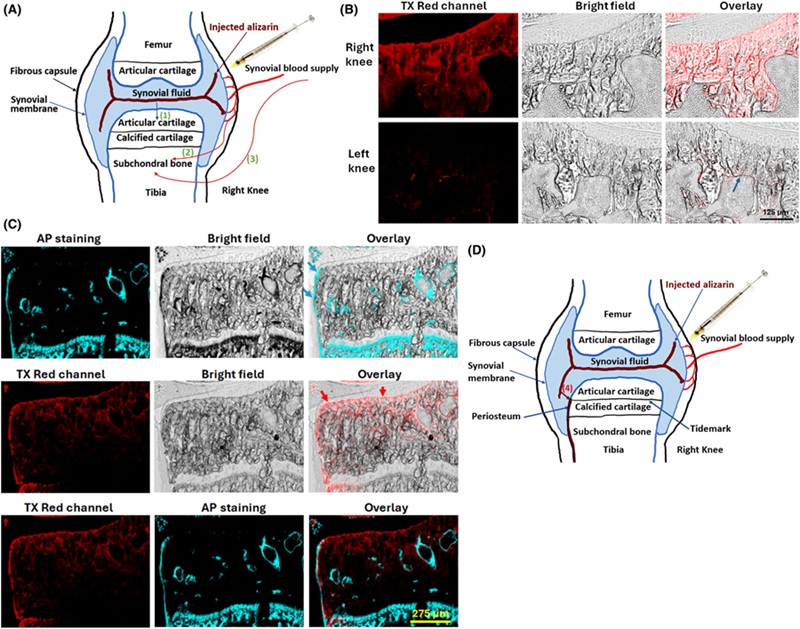Fluorescent Dye Reveals Biochemical Conversations Between Cartilage and Bone in Early Osteoarthritis
|
By HospiMedica International staff writers Posted on 08 Oct 2024 |

Osteoarthritis (OA) is a painful condition where the cartilage in a joint deteriorates, causing bone-on-bone contact. This articular cartilage also calcifies, turning into bone. The progressive condition is prevalent in individuals over 60, as well as those with certain metabolic disorders or who experience repetitive joint stress. Although there is no cure, early interventions may help slow further damage. However, detecting OA in its early stages, before the onset of pain, has been challenging. Now, researchers have discovered that a fluorescent dye might allow them to "listen" to biochemical interactions between cartilage and bone during the earliest stages of OA—even before pain begins. This unexpected discovery, made through research on mice, could pave the way for new treatments.
Researchers at Sidney Kimmel Medical College of Thomas Jefferson University (Philadelphia, PA, USA) investigated whether articular cartilage becomes calcified in the early stages of OA. They used a mouse model in which the right knee displays symptoms resembling those of human OA. The team injected a fluorescent red dye called alizarin complexone, which binds to calcium-containing crystals, into both knees. Surprisingly, they found no fluorescence on the surface of the articular cartilage, where they had expected to see early calcification. Instead, the dye stained the tidemark region, a boundary between the articular cartilage and the layer of calcified cartilage on the bone. The researchers also observed that the osteoarthritic mice had more alizarin dye in the calcified cartilage and subchondral bone compared to the controls. This increased dye diffusion suggests that the knee joint in early OA is more permeable than in normal joints.
When injected, the dye first enters the synovial fluid, which lubricates the joints. In additional experiments, the team found that the dye moved throughout the joint via three expected pathways. However, they also discovered a new pathway, through the tidemark, into the blood vessels in the outer bone layer, known as the periosteum. The fluorescence signal was stronger in the periosteum and subchondral bone of OA-affected joints compared to controls. These findings, published in FASEB BioAdvances, reveal that alizarin complexone can detect diffusion, or biochemical communication, between the articular cartilage, calcified cartilage, and subchondral bone. This diffusion is heightened in the early stages of OA. With this new tool, researchers can further explore OA progression, potentially leading to the development of novel treatments.
Latest Critical Care News
- Novel Cannula Delivery System Enables Targeted Delivery of Imaging Agents and Drugs
- Ingestible Smart Capsule for Chemical Sensing in the Gut Moves Closer to Market
- Novel Intrabronchial Method Delivers Cell Therapies in Critically Ill Patients on External Lung Support
- Generative AI Technology Detects Heart Disease Earlier Than Conventional Methods
- Wearable Technology Predicts Cardiovascular Risk by Continuously Monitoring Heart Rate Recovery
- Wearable Health Monitoring Device Measures Gases Emitted from and Absorbed by Skin
- Groundbreaking Technology Rapidly Detects Airborne Influenza Viruses
- Handheld Device Could Transform Heart Disease Screening
- Flexible Semi-Autonomous Robot Could Deliver Medicine Inside Body

- Neurorestorative Treatment Strategies Hold Promise for Most Severe Forms of Epilepsy
- Gene Discovery Could Help Grow New Heart Arteries
- Study Discovers Invisible Transmission of Common Hospital-Associated Infection
- Non-Invasive Neuro-Ophthalmology Techniques Could Detect Brain Tumors Earlier
- Mass Manufactured Nanoparticles to Deliver Cancer Drugs Directly to Tumors
- World’s Smallest Pacemaker Fits Inside Syringe Tip

- AI-Powered, Internet-Connected Medical Devices to Revolutionize Healthcare, Finds Study
Channels
Surgical Techniques
view channel
Intravascular Imaging for Guiding Stent Implantation Ensures Safer Stenting Procedures
Patients diagnosed with coronary artery disease, which is caused by plaque accumulation within the arteries leading to chest pain, shortness of breath, and potential heart attacks, frequently undergo percutaneous... Read more
World's First AI Surgical Guidance Platform Allows Surgeons to Measure Success in Real-Time
Surgeons have always faced challenges in measuring their progress toward surgical goals during procedures. Traditionally, obtaining measurements required stepping out of the sterile environment to perform... Read morePatient Care
view channel
Portable Biosensor Platform to Reduce Hospital-Acquired Infections
Approximately 4 million patients in the European Union acquire healthcare-associated infections (HAIs) or nosocomial infections each year, with around 37,000 deaths directly resulting from these infections,... Read moreFirst-Of-Its-Kind Portable Germicidal Light Technology Disinfects High-Touch Clinical Surfaces in Seconds
Reducing healthcare-acquired infections (HAIs) remains a pressing issue within global healthcare systems. In the United States alone, 1.7 million patients contract HAIs annually, leading to approximately... Read more
Surgical Capacity Optimization Solution Helps Hospitals Boost OR Utilization
An innovative solution has the capability to transform surgical capacity utilization by targeting the root cause of surgical block time inefficiencies. Fujitsu Limited’s (Tokyo, Japan) Surgical Capacity... Read more
Game-Changing Innovation in Surgical Instrument Sterilization Significantly Improves OR Throughput
A groundbreaking innovation enables hospitals to significantly improve instrument processing time and throughput in operating rooms (ORs) and sterile processing departments. Turbett Surgical, Inc.... Read moreHealth IT
view channel
Printable Molecule-Selective Nanoparticles Enable Mass Production of Wearable Biosensors
The future of medicine is likely to focus on the personalization of healthcare—understanding exactly what an individual requires and delivering the appropriate combination of nutrients, metabolites, and... Read more
Smartwatches Could Detect Congestive Heart Failure
Diagnosing congestive heart failure (CHF) typically requires expensive and time-consuming imaging techniques like echocardiography, also known as cardiac ultrasound. Previously, detecting CHF by analyzing... Read moreBusiness
view channel
Expanded Collaboration to Transform OR Technology Through AI and Automation
The expansion of an existing collaboration between three leading companies aims to develop artificial intelligence (AI)-driven solutions for smart operating rooms with sophisticated monitoring and automation.... Read more

















